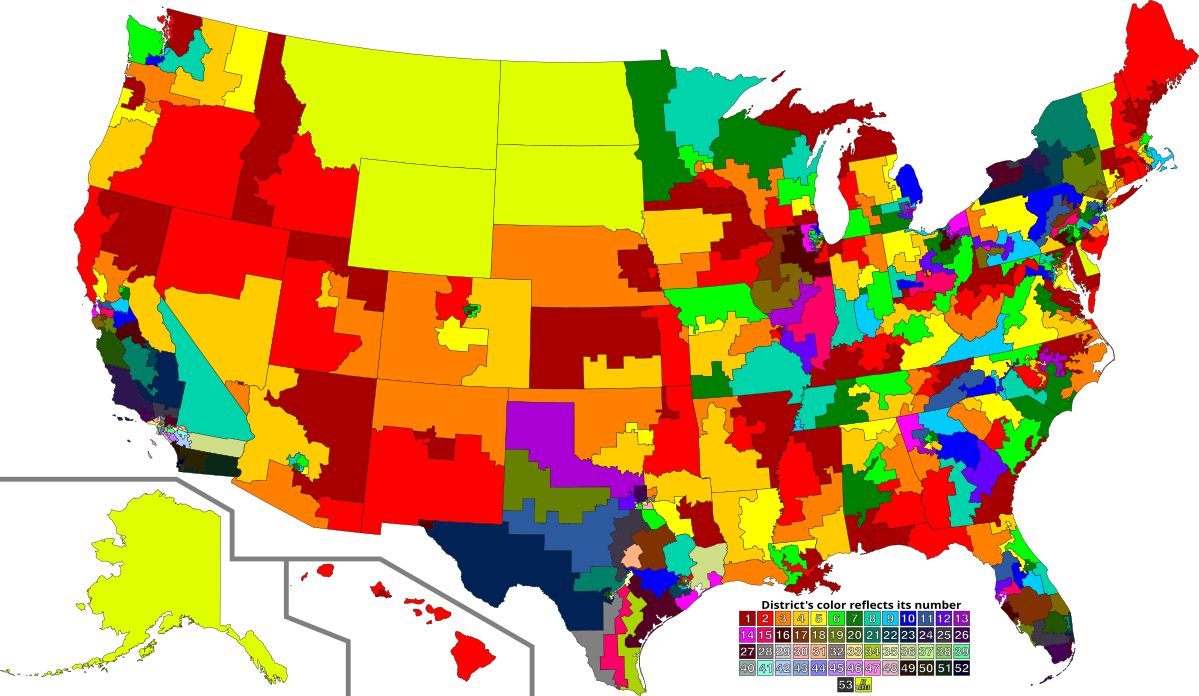
Congressional Redistricting
What would the US House look like if other countries joined the US?
Unitism & Congressional Redistricting
How would US House & Electoral College representation be apportioned if other countries joined the US?
Current US House representation: 435 members (not specified in the Constitution, but rather set by Congress with the assent of President Woodrow Wilson in 1911). While we’re discussing expanding the United States, why not consider expanding the size of the US House from 435 to, say, 600 (the number of Senators in the Roman Senate at the beginning of the Roman Empire)? Perhaps that’s another discussion …
The current (estimated) population of the United States in 2024 is 335,893,238, so currently each of the 435 members of the United States House of Representatives represents 772,168 constituents (at least in theory; the practice of apportionment among the states results in some constituencies being under- or overrepresented [e.g., the State of Wyoming has only 576,851 inhabitants, yet, per the Constitution, has its own member in the US House]).
Note that all theoretical United States below would of course be entitled to representation by two Senators in the United States Senate in addition to their representation in the US House based on population.
Also note that there’s a very relevant precedent regarding (at least temporarily) increasing the size of the US House upon the addition of new states. In 1959, upon the admission of Alaska and Hawaii as states, each was granted an instant representative in the House (creating a new temporary total of 437 representatives) until 1963, at which point Congress went back to apportioning the old total of 435 reps.
Perhaps the US could use this opportunity to expand the House (and thus improve representation) by permanently granting the new representatives a new United State would receive (based on population)? (This might have a certain appeal to the representatives of current United States that have lost representation in the House over the years due to shrinking state populations; these states’ losses of representation would be slowed and their current representatives would have a bit more job security. The 50 Homeland States could even take the opportunity to expand their own representation to a collective total of, say, 600 even, by making the argument that increased representation would be a counterweight.)
Note the below calculations are based on single-state (one-at-a-time) admissions of new states.
The Unity Party of Australia (2024 population: 27,122,411): If Australia were to become the 51st State of the United States, it would most likely instantly receive 35 representatives in the United States House, for a new total of 470 US House Representatives (27,122,411/772,168=35)
The Unity Party of Bosnia and Herzegovina (2024 population: 3,157,078): 4 instant representatives, for 439 total
The Unity Party of Germany (2024 population: 84,410,654): 109 instant representatives, for 544 total
The Unity Party of the Netherlands (2024 population: 18,228,742): 24 instant representatives, for 459 total
*The Unity Party of Israel (2024 population: 9,974,300): 13 instant representatives, for 448 total
*The Unity Party of Palestine (2024 population: 5,090,889): 7 instant representatives, for 442 total
The Unity Party of Sweden (2024 population: 10,606,999): 14 instant representatives, for 449 total
The Unity Party of Switzerland (2024 population: 8,935,540): 12 instant representatives, for 447 total
*Note that the Israeli population numbers do not include inhabitants of the West Bank and Gaza Strip, which together the Unity Party considers the basis of a future Palestinian state (or states), per the “Self-Determination of All Peoples” Amendment XVIII to the Constitution of the Unity Party of America. (If the West Bank were to join the United States independently, its population of 2,949,246 would earn it four Representatives in the US House plus two US Senators. If Gaza were to join the United States independently, its population of 2,141,643 would earn it three Representatives in the US House plus two US Senators.)
And what does this mean in terms of the Electoral College? The US Electoral College, as it currently stands, is composed of 538 Presidential Electors (435 US House Representatives + 100 US Senators + 3 DC votes).
The Unity Party of Australia (2024 population: 27,122,411): If Australia were to become the 51st State of the United States, it would most likely instantly be entitled to 37 votes in the Electoral College (35+2=37), out of 575 votes total
The Unity Party of Bosnia and Herzegovina (2024 population: 3,157,078): 6 Electoral College votes, for 544 total
The Unity Party of Germany (2024 population: 84,410,654): 111 Electoral College votes, for 649 total
The Unity Party of the Netherlands (2024 population: 18,228,742): 26 Electoral College votes, for 564 total
The Unity Party of Israel (2024 population: 9,974,300): 15 Electoral College votes, for 553 total
The Unity Party of Palestine (2024 population: 5,090,889): 9 Electoral College votes, for 547 total
The Unity Party of Sweden (2024 population: 10,606,999): 16 Electoral College votes, for 554 total
*The Unity Party of Switzerland (2024 population: 8,935,540): 14 Electoral College votes, for 552 total
*Note that, since Switzerland is a landlocked country, as a practical matter the admission of Switzerland would necessitate the admission of Germany (or another country adjoining both the Swiss and the sea)
Header photo credit: Magog the Ogre

